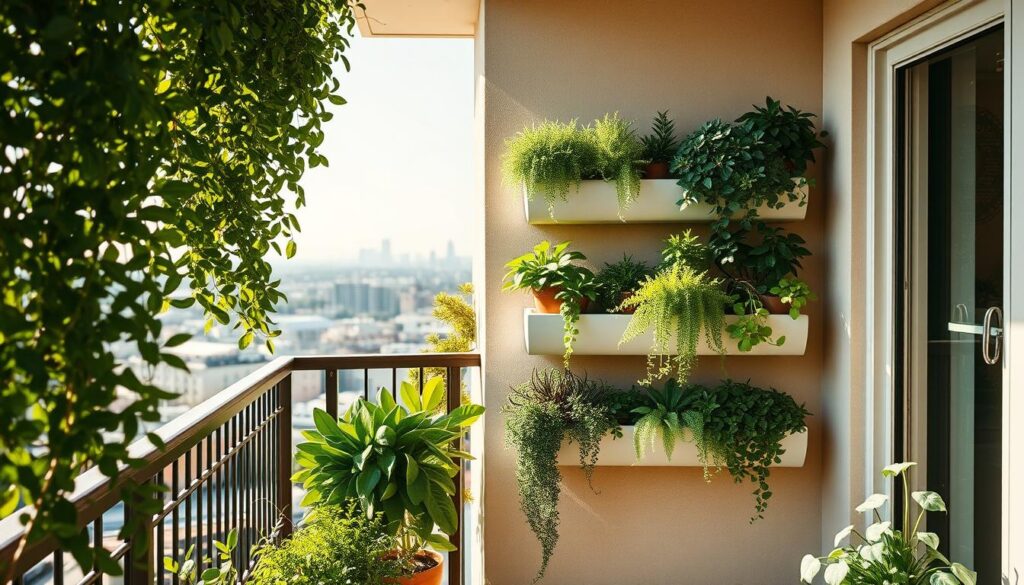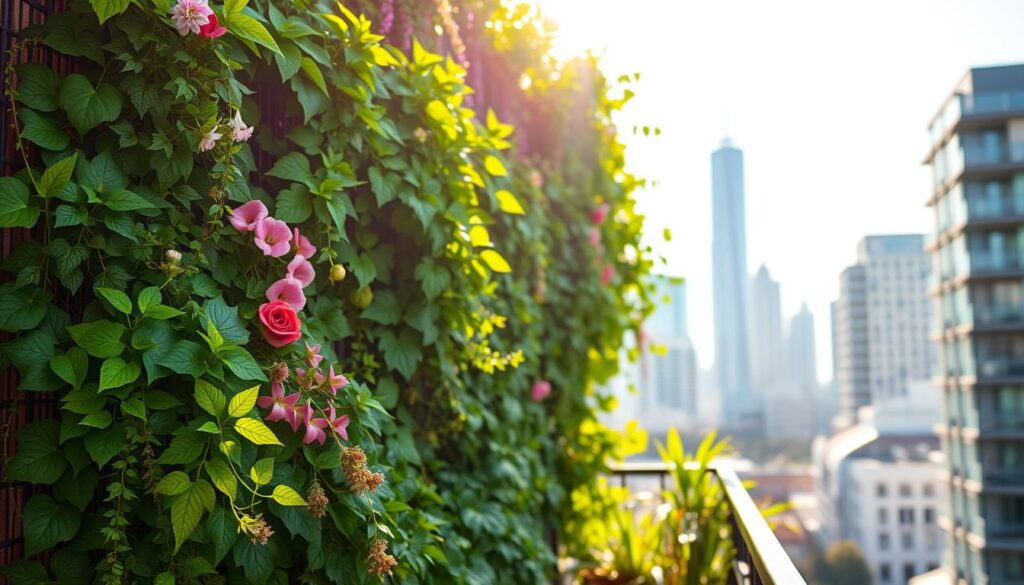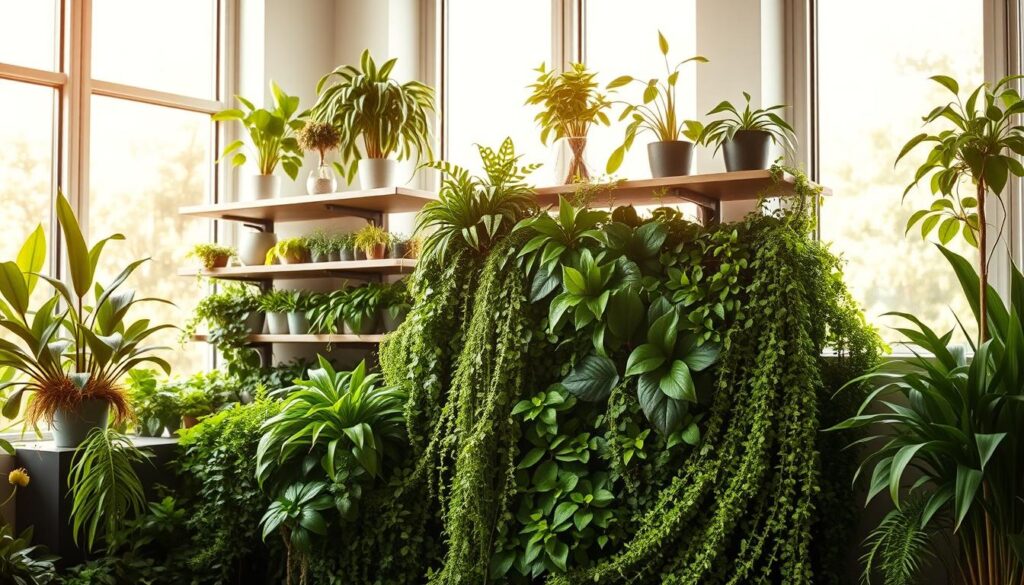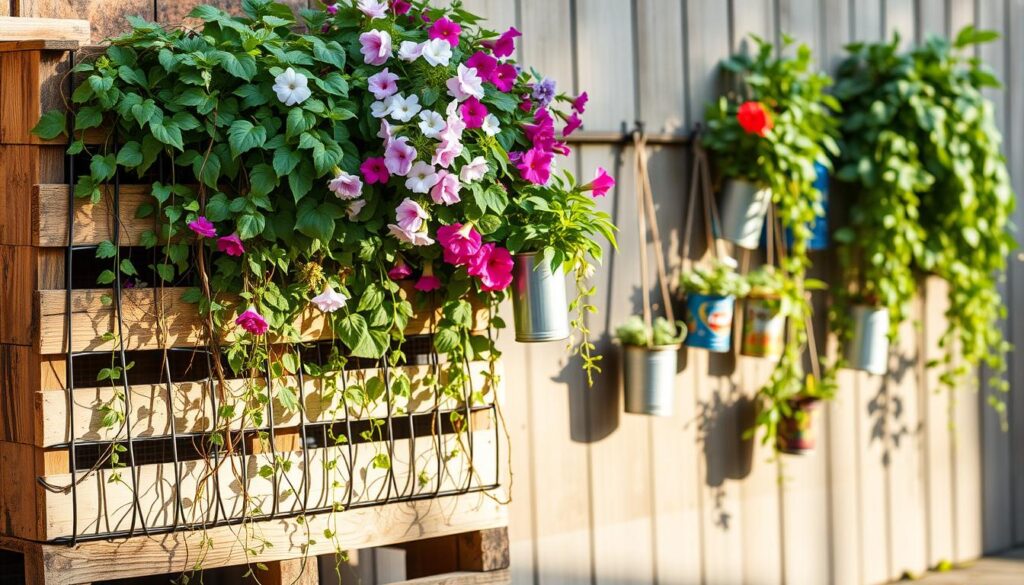
4 Genius Vertical Garden Ideas for Small Spaces
Do you feel like your small outdoor or indoor space limits your gardening dreams? Can you really create a lush oasis in a compact area? Yes, you can, thanks to Vertical Garden design.
For city folks and those with little space, Vertical Garden ideas are a creative fix. They let you turn walls and vertical surfaces into green spaces. This way, even the tiniest areas can become lively and full of life.
This article will dive into four smart ways to add a Vertical Garden to your small space. It will help you make the most of your area and enjoy gardening’s many perks.
Understanding Vertical Gardens and Their Benefits
As cities grow, people want to bring nature into their homes. Vertical gardens are a big hit for this reason. They help make urban areas look and feel better.
Vertical gardens turn blank walls into green spaces. They mix function and beauty in a unique way.
What is a Vertical Garden?
A vertical garden, or living wall, lets plants grow up walls. You can use soil, hydroponics, or other mediums to grow them.
Benefits of Vertical Gardening
Vertical gardens are great for many reasons. They make spaces look better and improve air quality. They also help cool down cities and block out noise.
They’re perfect for saving space in crowded cities. Vertical gardens let you add greenery even when you don’t have much room.
Ideal Plants for Vertical Gardens
Choosing plants for vertical gardens is easy. Herbs, succulents, and flowering plants are top picks. They’re tough and grow well in different conditions.
Herbs like basil and mint are great for cooking. Succulents need less water, perfect for dry spots. Flowering plants add color and beauty to any space.
Preparing Your Small Space for a Vertical Garden
To make the most of your limited space, careful preparation is key. This means understanding the dimensions and conditions of your area. It’s all about creating a stunning Vertical Garden design.
Measuring Your Space
The first step is to measure your space accurately. This helps you figure out the best layout for your vertical garden. Think about the height and width of the wall or area you plan to use. Accurate measurements are crucial for choosing the right size and number of planters or a vertical gardening system.
When measuring, also think about the space needed for maintenance. Make sure you have enough room to water, prune, and inspect your plants comfortably. A well-planned layout will make caring for your vertical garden much easier.

Assessing Light and Wind Conditions
Understanding the light and wind conditions in your space is vital. Observe how much sunlight your area receives daily. Different plants have different light requirements, so it’s essential to choose plants that match your space’s conditions.
Wind is another critical factor. Strong winds can damage plants and structures. If your space is exposed to wind, consider using windbreaks or choosing plants that are more resilient to windy conditions.
By carefully measuring your space and assessing its light and wind conditions, you can create a thriving vertical garden. This will enhance your area’s beauty and functionality.
Vertical Garden Ideas for Balcony Spaces
Turning your balcony into a lush oasis is easier than you think. With the right ideas, balconies can become vibrant green spaces. A little creativity and the right gardening solutions can make it happen.
To make the most of your balcony space, consider rail-mounted planters and hanging pots and tiers. These options add beauty and make the most of available space.
Rail-Mounted Planters
Rail-mounted planters are great for adding greenery to your balcony. They don’t take up floor space, making them perfect for small areas.
Using rail-mounted planters offers several benefits:
| Benefits | Description |
|---|---|
| Space Efficiency | Utilizes the often-wasted railing space |
| Ease of Installation | Easy to attach and detach |
| Flexibility | Can be moved or rearranged as needed |
Hanging Pots and Tiers
Hanging pots and tiers are another great choice for balcony gardens. They can be hung from the ceiling or the railing, adding layers of greenery.
Choosing the right plants is key for a successful balcony garden. Plants like petunias, ivy, and succulents are perfect. They’re hardy and easy to care for.

By using rail-mounted planters and hanging pots and tiers, you can create a stunning vertical garden. It will enhance your outdoor living experience beautifully.
Creative Wall-Mounted Vertical Gardens
Turning your wall into a lush Vertical Garden is simple. You can choose from many creative and eco-friendly options. A wall-mounted Vertical Garden brings greenery to your space and uses your wall efficiently. It’s ideal for small areas.
There are many ways to make a wall-mounted Vertical Garden. You can use reclaimed materials or stylish planters. Pallet gardening and pocket planters for succulents are two popular methods.
Pallet Gardening
Pallet gardening is cost-effective and eco-friendly. It turns old pallets into a thriving garden. This adds a rustic feel to your space.
To start, clean and disassemble the pallet. Then, reassemble it into a frame. Attach landscape fabric to the back and bottom for plant pockets. Fill these with soil and plant your greenery. It’s perfect for herbs, strawberries, and small plants.
Pocket Planters for Succulents
Pocket planters are a stylish choice for a Vertical Garden, great for succulents. They have individual pockets that attach to the wall. This creates a unique and beautiful display for your plants.
To make a succulent Vertical Garden, pick a planter that fits your wall. Fill each pocket with soil and plant your succulents. Choose succulents that like similar conditions to keep your garden healthy.
This method is not only beautiful but also easy to maintain. Succulents need little water and care. It’s a great Vertical Garden DIY project for adding greenery indoors or outdoors.
Utilizing Indoor Spaces with Vertical Gardening
Vertical gardening isn’t just for outdoors; it can also make indoor spaces greener. It brings many benefits like better air, looks, and less stress.

Vertical Wall Planters for Indoor Herbs
Indoor vertical gardening is great for growing herbs. Vertical wall planters are perfect for this, fitting many herbs in a small space. Choose herbs like basil, mint, and parsley for indoor gardens.
Herbs need bright, indirect light to grow well. Place them near a sunny window or under grow lights.
Shelving Units for Houseplants
Shelving units are also good for indoor vertical gardening. They let you show off houseplants, adding green to rooms.
For shelves, pick plants that do well indoors and need little care. Snake plants, spider plants, and pothos are great choices. They’re tough and grow well in different lights.
Vertical gardening indoors makes spaces unique and beautiful. It also helps improve well-being.
Vertical Gardening with Recycled Materials
Using recycled materials for vertical gardening is good for the planet. It also makes your space unique. This method is both eco-friendly and lets you get creative with your design.
Repurposing materials for your vertical garden can be simple or complex. It’s about seeing everyday items in a new way. Imagine how they can support your plants.
Upcycled Wooden Boxes
Wooden boxes are a top choice for upcycling in vertical gardening. You can use old crates, wooden drawers, or even pallets. Upcycled wooden boxes look great on walls or as freestanding units. They add a rustic charm to your plants.
To start, pick boxes of different sizes. Make sure they’re clean and dry before adding soil and plants. You can arrange them on a wall or stack them for a tiered look.

Plastic Bottle Planters
Plastic bottle planters are another creative option for vertical gardening. Cutting plastic bottles in half makes mini planters from waste. You can hang them from a frame or attach them to a wall.
To make a planter, cut the bottle in half, fill it with soil and a plant, and hang it up. You can also paint or draw on the bottles for a personal touch.
Both wooden boxes and plastic bottle planters let you express your creativity in vertical gardening. By reusing materials, you’re making a beautiful garden and helping the environment.
Choosing the Right Vertical Gardening System
The right vertical gardening system can make all the difference in achieving a lush and vibrant garden. With various options available, it’s essential to consider your specific needs and preferences.
When deciding on a vertical gardening system, you have two primary options: freestanding vertical garden kits and wall-mounted systems. Each has its unique advantages and is suited to different environments and user preferences.
Freestanding Vertical Garden Kits
Freestanding vertical garden kits offer flexibility and ease of use. They can be placed anywhere in your garden or indoor space without the need for wall mounting. These kits are ideal for those who may not have a suitable wall or prefer not to make any permanent changes to their walls.
Advantages of Freestanding Kits:
- Ease of mobility
- No damage to walls
- Versatility in placement
Wall-Mounted Systems
Wall-mounted systems provide a more permanent solution and can be a beautiful addition to any wall. They are perfect for maximizing space and can be used both indoors and outdoors. These systems are ideal for those who have a suitable wall and want a more integrated look.
Advantages of Wall-Mounted Systems:
- Space-saving
- Aesthetic appeal
- Can be used with a variety of plants
To help you make an informed decision, here’s a comparison of the key features of freestanding and wall-mounted vertical gardening systems:
| Feature | Freestanding Kits | Wall-Mounted Systems |
|---|---|---|
| Mobility | High | Low |
| Wall Damage | No | Yes |
| Space Requirements | Floor Space | Wall Space |
| Aesthetic Appeal | Variable | High |
When choosing between these systems, consider factors such as the available space, your budget, and your personal preferences. By weighing these factors, you can select the vertical gardening system that best suits your needs and enjoy the many benefits of vertical gardening.
Maintenance Tips for Small Vertical Gardens
To keep your vertical garden thriving, it’s crucial to understand the basics of maintenance. A well-maintained vertical garden not only enhances the aesthetic appeal of your space but also ensures the health and longevity of your plants.
Watering and Fertilizing
Proper watering is essential for the health of your vertical garden. Overwatering can lead to root rot and other issues, while underwatering can cause stress to the plants. Check the soil moisture regularly by inserting your finger into the soil up to the first knuckle; if the soil feels dry, it’s time to water.
Fertilizing is also crucial as it provides necessary nutrients for plant growth. Use a balanced, water-soluble fertilizer during the growing season (spring and summer). Dilute the fertilizer to half the recommended strength to avoid burning the roots.
| Plant Type | Watering Frequency | Fertilizing Schedule |
|---|---|---|
| Herbs | Every 2-3 days | Every 2 weeks |
| Succulents | Every 7-10 days | Every 4 weeks |
| Flowering Plants | Every 3-4 days | Every week |
Pest Control Strategies
Pests can be a significant problem for vertical gardens. Regularly inspect your plants for signs of pests such as aphids, spider mites, or mealybugs. Isolate infected plants to prevent the pests from spreading to other plants.
For organic pest control, use neem oil or insecticidal soap. These products are effective against a wide range of pests and are safer for the environment than chemical pesticides.
By following these maintenance tips, you can enjoy a thriving and healthy vertical garden that adds beauty and freshness to your small space.
Vertical Garden Success Stories
Vertical gardens have changed how we use small spaces, indoors and outdoors. They make the most of space and add greenery, becoming a favorite for homeowners. This way, they can make their living areas better.
Balcony Transformations
Vertical gardening is great for turning unused balcony spaces into green oases. Homeowners can use rail-mounted planters or hanging pots to do this. It creates a peaceful spot in the city’s noise.
A small balcony can become a lively garden with different plants. You can have flowering vines or fragrant herbs. It makes the space look better and offers a quiet place to relax.
Indoor Vertical Gardens that Impress
Indoor vertical gardens are not just pretty; they also improve air quality and mood. Homeowners can use wall-mounted systems or freestanding kits to create a stunning feature. This works well in living rooms or offices.
A well-made indoor vertical garden can have many plants, like succulents or ferns. It makes a unique and eye-catching display. This is perfect for modern, simple spaces where greenery adds warmth and character.
Vertical gardens are a great way to improve your balcony or living room. With the right setup and care, they become a beautiful centerpiece. They add beauty and value to your home.
Conclusion: Transform Your Space with Vertical Gardening
Adding a vertical garden to your small space can change everything. It brings in greenery and makes your home look better.
Start Your Vertical Gardening Journey
Now you know about different vertical garden ideas. It’s time to start. First, look at your space and pick the best vertical gardening system for you. Think about the light, wind, and the plants you want.
Explore More Vertical Garden Inspiration
For more ideas, check out gardening blogs and social media. You can also find books and magazines on vertical garden design. They’ll help you begin your project.
Leave a Reply